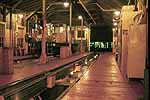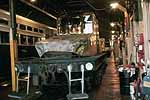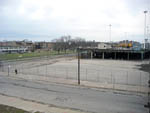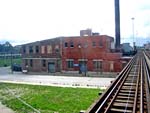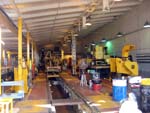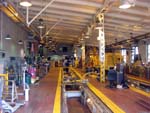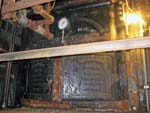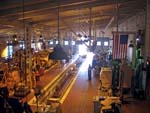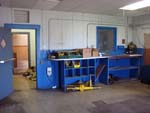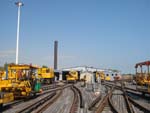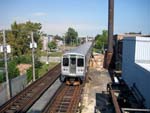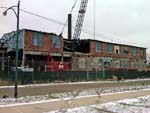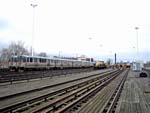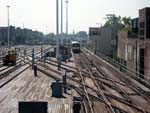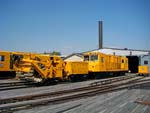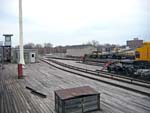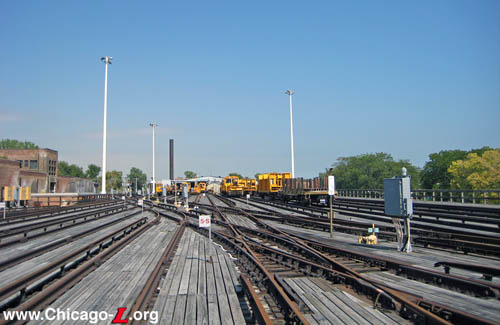
The elevated yard at 61st Street is seen looking north on September 18, 2009. The yard tracks in the north half of the yard have various pieces of work equipment stored on them, and the 61st Shops building is visible in the background. The shop was demolished in early 2010. For a larger view, click here.
(Photo by Graham
Garfield)
|
61st Yard & Shops
Lower 63rd Yard
63rd Street and Calumet
Avenue, Washington Park
Service
Notes:
|
Located:
|

|
Green Line: East
63rd
|
|
Services:
|

|
All routes,
maintenance/nonrevenue stock
|
Quick Facts:
Address: 329 E. 61st
Street (61st Shops)
Established: 1893 (61st Yard); 1905 (63rd Yard)
Shop Area: |
61st Shops: 47,373 square feet |
|
63rd Non-revenue Shop: 69,184 square feet (planned) |
Yard Area: 206,392 square feet
Rebuilt: n/a
|
Status:.. |
61st Shops: Demolished |
|
|
61st and 63rd Yards: In Use |
When
the South Side Rapid Transit began operations in 1892, they had a
serious deficiency: where to store cars and make repairs. The
original Congress-to-39th line had no yard or maintenance shop; idle
cars were stored on the main line south of the last open station
(usually 39th Street).
Locomotives were serviced at a small facility built south of
39th. Coal was received from
the Chicago Junction Railroad at this location as well.
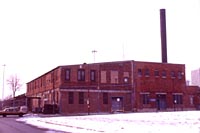
A view of the 61st Street Shop from the corner of 61st and Calumet, looking southwest in December 2002. For a larger view, click here. (Photo by John Smatlak) |
As part of the South Side's extension to Jackson Park, a full yard
facility was built where the line turned east over 63rd Street from
the alley between Prairie and Calumet. The elevated coach yard
covered a two block region from 61st to 63rd, and included a large engine
house in the southwest corner of the yard for the servicing of the
steam locomotives augmented the 39th Street shop. The South Side Rapid Transit Company began occupation of the yard on January 22, 1893, concurrent with the control of the railroad being officially turned over from the Rapid Transit and Bridge Construction Company, the contractor who built the line, to the "L" company, and the first train was dispatched from the yard to Congress Street at 12:01am, January 23. A.J. McBlair, chief of the SSRT traffic department, said, "With this new yard to do our switching in the road will give the public much better service. Ever since we commenced operations we have been handicapped by being compelled to do all our business on two tracks. The new yards have twelve tracks, giving us ample facilities for switching without delay and also for heating the cars."1
In 1897, the South Side Elevated began work to retire their steam
locomotives and covert the line not only to electric traction but to
Sprague's experimental multiple unit control (the first major
application of the technology). Another major improvement that year
was the construction of a shop building in the 61st Street Yard. The
shops were at the north end of the yard, fronting 61st Street, with a
connection to the northbound platform of the 61st
Street station. The first floor housed the carpentry and tin
shops, a storeroom, and an employee area. The second floor
(track-level) contained offices, a three-track repair shop, and a
four-track paint shop. The crew terminal and trainroom was also located on the track-level second floor of the facility.
Interestingly, concurrent with
electrification, the yard began to use low-slung trolley wire on the
lead (ladder) tracks because of fears that trains could become
stranded on dead sections of the third rail at switches. (No other
part of the South Side elevated used overhead wire.) The company
engineers designed a unique bow trolley for roof the cars that was
always in the upright position, which was fitted onto all South Side
cars in 1893, as well as Northwestern 1-59 series motors circa 1912
(presumably in anticipation of the beginning of crosstown
service).
Lower 63rd Yard, Interurban Freight Service Added
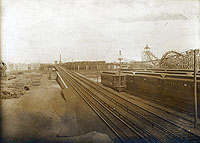
An early postcard view of the Lower 63rd Yard, looking north with the elevated 61st Yard in the background. Although the postcard is dated 1908, there is no evidence of any overhead wire operation as would be expected between 1905 and 1913, making a conclusive date unclear. The roller coaster on the right is in the adjacent White City Amusement Part at 63rd and South Park. For a larger view, click here. |
In 1905, concurrent with the South Side's last expansion of their
39th Street power house, the company purchased a large tract of land
on the south side of 63rd Street at Calumet Avenue, adjacent to the
61st Street Yard. A large car storage yard was built at surface level
and plans were developed for the construction of a shop to handle
heavy repairs at a later date. (One was never built.) The 63rd Street
Yard also used over head trolley wire for power until 1913. The yard
included an interchange track with the Lake Shore & Michigan
Southern Railroad (later part of the New York Central System, still later a
part of Conrail, now owned by CSX). This gave the South Side a second place to take
coal deliveries. A number of cars were actually delivered via this
spur (including 5000-series
cars 5001 and 5002 from Pullman on Chicago's South Side), as were
supplies. The 63rd Yard was connected to the 61st Yard via a long
ramp that connected to the elevated main line tracks just north of
63rd Street and descended across the street and down into the
yard.
Through-routing of Northwestern and South Side trains began in
November 1913 and as a result, some Northwestern Elevated cars were
occasionally stored in the 61st/63rd Yards. Overhead trolley
operation in the yards was discontinued at that time; apparently, the
engineers had determined that the chances of a car getting stranded
were not as great as they had feared. By this time, an additional car
inspection shop had been built on the two most eastern tracks in the
61st Yard. Constructed of wood, it was long enough to accommodate two
8-car trains side by side, whereas the 61st Shops could only take a
few cars on each track.
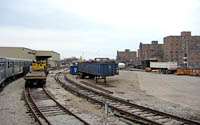
The Lower 63rd Yard is seen looking north from its south end, where the tracks curve to parallel the ex-NY Central tracks, on March 28, 2010. The yard only consists of a few tracks; much of the east half is land for materials storage. The building on the left is a warehouse. The 2200-series cars on the left are in the yard for an IRM fantrip. For a larger view, click here. (Photo by Graham Garfield) |
The Lower 63rd Yard also had a useful secondary purpose for the corporate interests controlled by Samuel Insull, whose portfolio included not only the "L" but also three Chicago area electric interurban railroads. Two of the interurbans -- Chicago North Shore & Milwaukee and Chicago Aurora & Elgin -- ran over the "L" into Chicago using trackage rights, and in addition to passengers also provided some level of freight service. The North Shore Line and CA&E carried items such as newspapers, baggage, and express and less-than-carload (LCL) merchandise dispatch (spelled "despatch" on company signage, equipment and documents rather
than "dispatch", owing to Chairman Samuel Insull's British heritage)
in regular interurban passenger cars,
combination passenger/baggage cars, or special freight cars, depending on the type of freight, that conformed to
"L"/interurban clearances and specifications. A freight house and loading terminal was established in 1919 on the North Side of Chicago at Montrose Avenue, at ground level at the south end of the "L"'s Wilson Yard property, where the LCL freight was loaded onto the interurban's cars. Satellite offices were established around the city to provide convenient drop-off points for customers, from which the parcels were shuttled to the Montrose facility by truck. Electric Railway Journal described the establishment of the merchandise dispatch office at the lower yard at 63rd and Calumet:
"Since Feb 15 1922, the Chicago North Shore & Milwaukee Railroad has been operating its Milwaukee limited trains through the loop to Sixty-third Street and Woodlawn Avenue on the south side providing an hourly service for south side business men and residents to and from Milwaukee and intervening cities. Similarly the merchandise dispatch service of the company was extended from the loop south and receiving stations located at Sixty-third Street and Calumet Avenue and Forty-first Street and Union Avenue at the Union Stockyards. This extension of the services of the company over the elevated structure to the south side of the city gives this section the same high grade service that is afforded to passengers boarding and leaving the trains in the loop or at north side stations." 2
Another ERJ article later in 1922 described the network of freight offices in more detail:
"Four receiving and delivering stations are provided in Chicago at convenient points. The principal station is at Franklin and Austin Streets near the Loop. On the south side is one on Sixty-third Street near Calumet and one at Forty-first and Union in the Stock Yards district The north side station is on Montrose Boulevard near Broadway. Cars are operated to the Montrose station and to the Sixty-third Street station Between Montrose and Franklin stations and between Sixty-third Street and Union Avenue station transfer is made by motor trucks. The North Shore Line owns and operates six 5 ton tractors and fifteen 10 ton trailers for use in making this transfer. Two stations are operated in Milwaukee the principal one which is 400 ft long with track capacity of ten cars is located on our main terminal property at Sixth and Clybourn Streets The other is at Harrison Street near the south city limits. Ample station facilities are also provided at Racine, Kenosha, Waukegan, North Chicago." 3
The North Shore Line abandoned LCL merchandise dispatch service in 1947.
In later years, the Lower 63rd Yard began to be used for materials
storage as well as the storage of retired rolling stock. After the CRT and CSL were consolidated into
the CTA in 1947, a connector track was constructed between the Lower
63rd Yard and the 63rd Street streetcar tracks.
CTA Era Developments
During the early years of CTA management, there was considerable shifting of engineering and maintenance responsibilities, equipment and personnel between locations. Some of this was in an effort to better unify the formerly separate rapid transit and surface companies, both for efficiency and to create a more integrated company culture. Some of the changes were simply between rapid transit locations, to centralize certain types of work or to create other economies. To this end, the 61st Street Air Brake Valve Department with all testing equipment was transferred to Skokie Shop on March 5, 1950. The 61st Street Air Compressor Overhaul Department was moved to West Shops on March 27, 1950.
The late 1970s saw a series of fires break out in the 61st/63rd
Yard complex. One evening in October 1978, a fire broke out in the
Lower 63rd Yard. Work locomotive S-343 was nearly lost in the fire,
but luckily the Chicago Fire Department was able to save it. It did,
however, sustain some serious damage. It turned out that there were
oxygen and acetylene tanks stored in the yard, which made for a
spectacular fire.
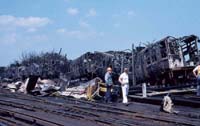
After the 61st Yard fire, CTA workers look over the wreckage of several cars burned and totaled in the blaze. Although completely unidentifiable down to the car number just by looking at the remains, seen here are cars 6335-6336, 6367-6368, and 2517-2518. For a larger view, click here. (Photo by Peter Vesic, from the John Dowdall Collection) |
On the morning of August 3, 1979, an extra-alarm fire consumed the
wooden inspection shop in the 61st Yard, which was known as the White
House. The White House was being used as a bad order repair shop at
the time. It was most likely set accidentally by iron workers that were doing
structure repair nearby. The fire started at the north end and
consumed the entire shop in minutes. Six cars inside were destroyed:
2517-2518, 6367-6368, and 6335-6336. Three cars outside and next to
the shop were also destroyed: 2481, 2447-2448. Two more cars,
2479-2480, were inside when the fire broke out but were saved by two
signal personnel that had just completed repairing the ATC. The shop
was never rebuilt and the structure was finally replaced several
years later. As one might imagine, the Jackson Park branch was
temporarily closed during the blaze and shortly afterward, with all
trains rerouted to Ashland on the Englewood branch.
In early 1991, a new heavy duty storage building was nearly
completion in the Lower 63rd Yard. The 700,000 square foot warehouse
measured 353 by 80 feet and had separate truck and rail loading docks
with bridge cranes. The $3.3 million facility replaced several
outmoded frame storage buildings and was expected to improve
operational efficiency significantly when it opened later in
1991.
Apparently, the 61st Yard and Shops were rehabbed in 1993. The 61st Shops building continued to house passenger car maintenance functions and a crew terminal into the 1990s. With the closure of the Green Line in 1994 for renovation, both of these functions ceased. The crew terminals for the south end of the Green Line were consolidated at Ashland/63rd Terminal when the line reopened in 1996, while the passenger car maintenance functions were absorbed by Harlem and Racine shops on the Green Line.
At that time, 61st Shops began to be used for the maintenance of non-revenue rail equipment such as the PCC 5-50, 61-65 and 6000-series work motors, as well as all the tampers, smoothers, flatcars, weed-sprayers, and other work cars. With the retirement of the PCC work motors, the crews at 61st Street no longer had to maintain motor cars, but they continued to handle work equipment, such as
snow-fighters, flatcars, ballast cars, and smoothers.
61st Shops Demolished
61st Shops was demolished in late winter 2009-10, sweeping away the last of the turn-of-the-20th century-era shop facilities on the rapid transit. The facility was demolished due to its deteriorated condition. By the time of its demolition, the building needed several structural and other repairs. As minor repair work and continued investigation of the building's deficiencies proceeded, it was found that the building's problems were more severe than anticipated. With the building housing limited functions and insufficient financial resources to bring the building back to a good state of repair, a decision was made to instead vacate and demolish the building and relocate its assigned functions. The elevated yard south of the shop building remains and was not included in the demolition.
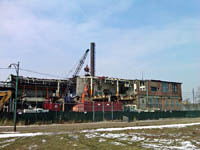
The demolition of the old 61st Shops building is well underway in this view looking west across Calumet Avenue on February 3, 2010. For a larger view, click here. |
On Friday, January 22, 2010, tracks 2N, 3N, 4N, 5N, 6N, 7N, 8N, 8S, and 9S, most of which led up to the shops, were taken out of service for the demolition of the building. CTA forces installed a guard rail along the north edge of the yard, so that once the building was demolished there would be a guardrail where the building used to be.
The work was contracted to FH Paschen, who subcontracted the demolition work to the Midwest Wrecking Company. On January 26, 2010, the contractor started hand demolition of wood decking and some non-structural steel members to separate the building from the track structure at the southeast corner of the building. The contractors demolished as much of the building by hand as they could, starting at the top of the shops' tall chimney. Once the chimney was demolished down to the level of the "L" structure, they finished the demolition using a crane with a clamshell bucket. Extreme care was needed during demolition since Green Line service runs immediately adjacent to the shops' former west elevation. The demolition work was completed on March 15, with the smoke stack the last part to be demolished. Foundation demolition and backfilling was completed on March 18, 2010.
The rail maintenance equipment functions at 61st Shops were transferred to Skokie Shops, while the carpenter shop that was located on the first floor moved to Building 2 at South Shops.
61st Yard continued to be used for the storage of rail maintenance equipment, while the Lower 63rd Yard continued to be used for material storage and loading purposes.
61st Yard Temporarily Reactivated
In 2013, the CTA launched the Red Line South Reconstruction Project, a track renewal project to rebuild the Dan Ryan branch tracks from the bottom up, excavating down to the bottom of the trackbed to rebuild the underground drainage system then installing new ballast, ties, and tracks. Some modest station improvements were also performed. In order to perform the work more quickly and cost-effectively, the CTA closed the Dan Ryan branch for five months while work was performed. During that time, there would be no 'L' service on the Dan Ryan branch south of Roosevelt station.
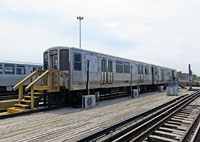
Cars 2273-74, seen looking southeast on May 20, 2013, were turned into a locker room (2274, foreground) and crew room while 61st Yard was used for passenger cars again. For a larger view, click here. (Photo by Graham Garfield) |
As part of the alternate service plan for Dan Ryan riders, Red Line trains were rerouted via the old 13th Street Incline from the State Street Subway to the South Side Elevated, where they operated to Ashland/63rd via the South Side Elevated tracks in a pattern reminiscent of the old Howard-Englewood "A" trains of the North-South Route days. Green Line service to Ashland/63rd was annulled, but Harlem-Cottage Grove Green Line trains continued to operate.
With the Red Line running to Ashland/63rd, Ashland Yard was used to capacity for north-south trains. Thus, 61st Yard needed to be reactivated for the duration of the Red Line South project to store and dispatch Green Line trains from the south end of the line. This would be the first time 61st Yard was used for storing and dispatching regularly-scheduled passenger trains since 1994.
In months leading up to its reactivation, 61st Yard received some maintenance to prepare it for the increased level of activity it would see. CTA Ironworkers renewed expansion pockets, X-Girders and flanges, while carpenters with contractor
F.H. Paschen replaced board decking along the walkways in the yard.
Green Line crews continued to report at the Ashland terminal, and then had to deadhead to the East 63rd branch to pick up their train or begin their other assigned duties, so a full terminal facility with clerks and an administrative staff was not required at 61st. However, with the old switching shanty in the yard in severe disrepair and 61st Shops, which formerly housed the terminal and crew facilities for the yard, demolished in 2010, temporary quarters were needed for the yard switchmen. 2200-series cars 2273-74, scheduled for retirement and scrapping, were converted for use as a break room (2273) and locker room (2274). The cars were taken to 61st Yard in April 2013 and parked on track #1S. Wooden stairs were installed to provided access up into each car, air conditioning units were installed on the catwalk below the car, and the windows for the locker room car were blacked out. The use of retired railcars for yard crew facilities has a long tradition on the "L", but was virtually unheard of since the 1980s.
Trains began to be dispatched from 61st Yard on May 19, 2013, the first day of the Dan Ryan closure and the new service pattern. Use of the yard continued until the end of the Red Line South project on October 20, 2013, after which Green Line trains resumed being stored and dispatched from Ashland Yard and 61st Yard returned to handling only nonrevenue equipment.
New Nonrevenue Equipment Maintenance Shop

A rendering of the proposed nonrevenue equipment maintenance shop at Lower 63rd Yard, looking south with 63rd Street and the East 63rd branch "L" in the foreground. For a larger view, click here. (Courtesy of CTA, from December 2020 Transit Board presentation) |
When the old 61st Shop was demolished in 2010 (see discussion above), the nonrevenue/work equipment maintenance functions that were housed there had to be relocated. At the time, these activities and the associated railborne maintenance equipment were moved to Skokie Shop, but even at the time this was a less-than-ideal solution -- Skokie was already a busy shop with limited excess capacity, and moving the nonrevenue equipment maintenance functions there exasperated that condition. It was a tight fit.
The long-term plan was to build a new vehicle maintenance shop for CTA's nonrevenue equipment, preferably at Lower 63rd Yard, but it would take time to find sufficient funding for the project. Eventually it was decided to take a phased funding approach, per the CTA FY 2017 -2021 Capital Improvement Plan Program of Projects; the total project cost was set at $60.8 million.
Planning and design took additional time. The shop is to be delivered through the Design-Build process. Planning for the project began in 2009. Design is planned to be complete in the 3rd quarter of 2021.4
The project calls for building a 69,000-square-foot maintenance facility fronting onto 63rd Street. The facilities are to provide for maintenance and repair of Power and Way equipment used for right-of-way maintenance, and of rail-mounted nonrevenue vehicles. The scope for the project required a facility with the ability to work on up to 16 vehicles at a time, rebuild equipment and manufacture parts, ability to clean equipment prior to commencing maintenance activities, and store adequate parts to shorten equipment downtime.5
The shop area of the facility is to include a shop/repair floor, power wash area, vehicle painting booth, steam-cleaning equipment room, machine room and welding room. Other planned functions for the facility include a battery shop, oil room, air compressor room, storage areas, lunchroom, classroom, and locker room. The project will also include an upgrade to the adjacent stormwater retention system and public art installations.6
At a Chicago Plan Commission (CPC) meeting at January 21, 2021, Sanford Stein, an attorney representing the CTA, said, "this is a proposal to bring [rail vehicle maintenance] back in a modern, new, architecturally pleasing building with considerable amenities -- environmental and aesthetic -- and to bring some of those jobs back to the city of Chicago."7
After a promise from CTA to the local alderman, Jeanette Taylor (20th Ward), for a community meeting about the project to solicit additional input, the Plan Commission approved the project to move forward.8
Construction is planned to begin in the 3rd quarter of 2021 and be completed in the 3rd quarter of 2023.9
Current Use of 61st and 63rd Yards
61st and Lower 63rd yards are used to store and stage nonrevenue equipment, such as work cars like flat cars, and maintenance of way equipment like sewer train cars and track maintenance vehicles. 63rd Lower Yard is also used for materials storage and warehousing.
As of 2019, the CTA still uses its connection between 63rd Lower Yard and the paralleling main line railroad, currently run by Norfolk Southern. CTA takes occasional deliveries of material, including ballast, via this connection.

- 1913 - 61st
Street Yard track map (196k): From Instructions to Trainmen in Connection with Through Routing: "The Interlocking Plant at 61st Street controls the movement of trains to and from the 61st Street Yard and 63rd Street Incline Tracks. South-bound lay-up trains that lay up in the 61st Street Yard are routed through cross-overs Nos. 5 and 7, and trains that are laid up in the 63rd Street Yard South-bound, leave the South-bound main line track at South end of 61st Street Yard, and enter 63rd Street Yard via Track C. During A.M. rush period cars are added and cut off South-bound, cross-over No. 13 being used for this purpose. During this period North-bound trains are routed over No. 1 Yard track through cross-overs Nos. 25 and 7. All switches East of Track No. 1 in the Yard are operated by hand, green and white being the signals used on switch stands."
Instructions to Trainmen in Connection with Through Routing, issued by CER to employees (1913) and reprinted in 1967 as Chicago Elevated Railroad: Consolidation of Operations, 1913. Graham Garfield Collection
.
- 1913 - 63rd
Street Surface Yard track map (216k): From Instructions to Trainmen in Connection with Through Routing: "The Interlocking Plant at 63rd Street Yard controls the operation of all targets and switches in this Yard. The diamond cross-over located at the foot of the incline tracks is used in crossing trains from one incline track to the other. When running North on the East lead, the targets are on the left-hand side of the track. This condition also applies to trains coming from the yard, on the inside lead."
Instructions to Trainmen in Connection with Through Routing, issued by CER to employees (1913) and reprinted in 1967 as Chicago Elevated Railroad: Consolidation of Operations, 1913. Graham Garfield Collection
.
- 1967 - 61st
Yard track map (150k)
CTA track map, from the Graham Garfield Collection
.
- 1967 - 63rd
Yard track map (134k)
CTA track map, from the Graham Garfield Collection
.
- 61st Yard Training Pamphlet, 1972 -- Page 1 (172k) | Page 2 (328k)
CTA training literature, from the Graham Garfield Collection
.
- 63rd Yard Training Pamphlet, 1972 -- Page 1 (164k) | Page 2 (292k)
CTA training literature, from the Graham Garfield Collection
.

61st Shops photos | 61st Yard photos | 63rd Yard photos
|
ctaS-343a.jpg (76k)
Service car S-343 started its life as locomotive C-50 (later L-202) for the Chicago Surface Lines, built in 1908. The car was transferred to the rapid transit division of the CTA circa 1957 and received an extensive rebuilding in June 1958. S-343 is seen here inside the White House inspection shop in the 61st Yard on November 10, 1978. Note that you can see the main 61st Shop in the background of the photo. (Photo by Peter Vesic) |
|
ctaS-343b.jpg (74k)
Service locomotive L-202 was renumbered S-343 circa 1959. A fire in the Lower 63rd Yard in October 1978 nearly destroyed S-343, as can be seen by the damage evident in the photo. It is seen here inside the White House inspection shop in the 61st Yard on November 10, 1978 shortly after a fire in the Lower 63rd Yard. S-343 is now at the Fox River Trolley Museum, where it has been stored to its CTA/L-202 appearance circa 1957. (Photo by Peter Vesic) |
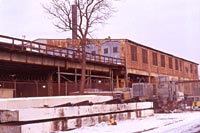 |
61stShops01.jpg (81k)
The 61st Street shop and elevated yard, looking northwest on adjacent Calumet Avenue in December 2002. (Photo by John Smatlak) |
|
61stYard14.jpg (74k)
61st Street Shop, looking north in the Upper 61st Street Yard on August 20, 2000. On an average day, several pieces of work equipment are usually in the yard. The tall smoke stack on the left is part of the old 1897 shop building, obscured behind the metal shop entrance. (Photo by Graham Garfield) |
|
61stShops03.jpg (168?k)
The 61st Shops is seen looking south from the Green Line East 63rd branch elevated structure on July 18, 2006. 61st Street is the street in front of the building. The street-facing elevation of the shop building had a very piecemeal appearance, with different sections consistent of varying brick colors and window heights, sizes, lintels and sills. The building seems to have been built in sections. (Photo by Graham Garfield) |
|
61stShops04.jpg (171k)
The interior of the west half of 61st Shops, housing tracks A, B and C, is seen looking north on September 18, 2009. Each shop track could only fit two cars, severely limiting the capacity of the shop. By the end of its life, the shop was servicing work cars and maintenance-of-way equipment. (Photo by Graham Garfield) |
|
61stShops05.jpg (188k)
By the time of its demolition, 61st Shops had been serving rapid transit equipment of various types for 113 years. It was the oldest maintenance facility on the "L" system, and was the last remaining example of a turn-of-the-20th-century shop building from the "L"'s early years. This interior view, looking north in the east half of the shop on September 18, 2009, shows its historic construction, complete with latticed steel columns and wooden floors. Some of the inspection track rails in the floor bore roll dates from the 1890s. (Photo by Graham Garfield) |
|
61stShops06.jpg (178k)
One of 61st Shops' legendary features was the original boiler in the basement. Dating from the original construction of the building, it still bore the name of its original company cast into its face plate: "THE CHICAGO & SOUTH SIDE RAPID TRANSIT CO." The boiler -- which had ceased to service the facility many decades earlier, but was too large and complicated to remove -- is seen on September 18, 2009. (Photo by Graham Garfield) |
|
61stShops07.jpg (178k)
The shop floor of the east half of the car inspection and maintenance facility at 61st Shops is seen looking down from the third floor mezzanine on September 18, 2009. Track D is the open track in the foreground; Tracks E (with a piece of snowfighter S-502 parked on it) and F are to the left. To the right, next to the wall, is an unnamed track that was disconnected from the yard many years ago. Behind the photographer, on the mezzanine level, was a locker room, kitchen and break room, and doorway to the terminal Transportation Office and trainroom. (Photo by Graham Garfield) |
|
61stShops08.jpg (117k)
The interior of the former clerk's office for the 61st Street Terminal trainroom is seen looking south on September 18, 2009 The window on the right was the clerk's window through which trainmen received their assignments, banks for conductors and ticket agents, and other paperwork and equipment for service. After the crew terminal at 61st closed, the office was used for other purposes. Through the open door is visible an office across the hallways used by Transportation management. (Photo by Graham Garfield) |
|
61stShops09.jpg (130k)
The 61st Shops building is seen looking north in 61st Yard on September 18, 2009. Note the smoke stack on the left from the shop building's old furnace. The shop doors are old heavy wooden doors that pivoted open, the last of their kind on the "L" system. All of the switches in this view are spring-and-stay switches; note the double slip switch on the right. (Photo by Graham Garfield) |
|
61st05.jpg (180k)
A Harlem-bound Green Line train passes by the former location of the 61st station platforms, looking north on September 18, 2009. The side platforms were on both sides of the tracks, and the inbound platform connected to the 61st Shops building on the right, which also housed the crew terminal and trainroom for the Jackson Park branch. The shop/terminal building was demolished about six months after the photo was taken. (Photo by Graham Garfield) |
|
61stShops10.jpg (165k)
Demolition has begun on the 61st Shops building, seen looking west along Calumet Avenue on January 26, 2010. Note that the shop building has already been disconnected from the yard tracks and structure on the left, making the break clean and the demolition easier. |
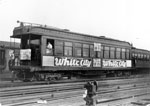 |
cer1034.jpg (146k)
Car 1034 is in 61st Street Upper Yard in 1913, shortly after through-routing between the North and South sides began. The car's exterior is covered in advertisements for the White City, an amusement park located a short distance from the yard at 63rd and South Park [King Drive], a precursor to the exterior ad wraps of today. The car, built as car 34 by Pullman as part of the Northwestern Elevated first order of motor cars in 1898, has had side destination sigh curtains recently installed. The end destination sign boxes on the roof would be removed shortly. The "S" painted on the cornerpost of the car indicates it's a smoking car. Car 1034 was among the last group of the original Northwestern motor cars with be retired, in June 1955. (Photo from the CTA Collection) |
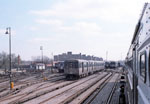 |
61stYard01.jpg (178k)
The 61st Street Yard is seen looking south on April 6, 1986 from a passing charter train of PCC cars. The yard has an array of 2000-series and 2600-series cars assigned to the North-South Route. (Photo by John Smatlak) |
 |
61stYard02.jpg (178k)
Various 6000-, 2000- and 2600-series cars are stored on the north yard tracks (identified in their track numbers with an "A" suffix at the time) of 61st Yard on April 6, 1986, seen from a passing charter train. The cars are wearing an array of paint schemes, from the mint green and alpine white introduced in the mid-1960s on car 6275 on the right (which has probably either just been or is about to be retired, as it last appeared on the active duty roster the year before), the Bicentennial scheme on the left, and the Bicentennial scheme's descendent, the Spirit of Chicago livery, in the middle. The maintenance shop is visible in the background. (Photo by David Wilson) |
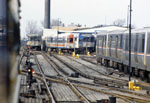 |
61stYard03.jpg (201k)
Passing the 61st Yard on April 6, 1986, cars of various series are seen stored between trips. Note the semaphore signals along the main line and on certain yard tracks. (Photo by David Wilson) |
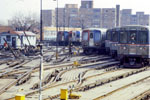 |
61stYard04.jpg (211k)
Several cars of the 6000-, 2000- and 2600-series are lined up on the storage tracks in 61st Yard, see looking southeast on April 6, 1986. Note the route flags on the switch stands with lighted indicators. The area in the left background roped off by the string of light bulbs is the former location of the "white house" maintenance shed, which caught fire and burned in 1979. After the wreckage and tracks were cleared, the damaged structure was left bare for a number of years before being repaired and new tracks laid on top. (Photo by David Wilson) |
 |
61stYard05.jpg (184k)
The southwest corner of 61st Yard is seen from a passing charter train of PCC cars led by Snowfighter cars S-425/S-426 (formerly 6507-08) on April 6, 1986. (Photo by John Smatlak) |
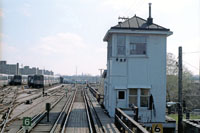 |
61stTower02.jpg (177k)
61st Tower, which controlled access in and out of 61st Yard on the left and the ramp down to Lower 63rd Yard beyond, is seen looking south from the main line tracks on April 6, 1986. Note the hand lanterns hung from the window where the towerman would work, to allow signals to be given at nighttime in the event of interlocking failure. (Photo by John Smatlak) |
 |
ROW@63rdYardRamp01.jpg (233k)
The ramp down to the Lower 63rd Yard, visible in the distance, is seen looking south from the Jackson Park main line tracks on April 6, 1986. (Photo by John Smatlak) |
 |
61stYard06.jpg (187k)
61st Yard is seen looking south from the main line tracks looking south from the home signal at the switch to the yard lead on June 28, 1992. The yard has recently been renovated, as evidenced by the new, tidy and orderly appearance of all the fixtures and equipment, and a new interlocking tower and signals installed. Despite this, the yard is actually in its last couple years of serving passenger cars. (Photo by David Wilson) |
|
61stYard07.jpg (45k)
Looking north in the long upper 61st Yard from the south end of the complex on August 20, 2000. Note the rail in the center of the photo that ends in the foreground: it is not associated with any track set around it and is, in fact, the third rail left over from the long-removed Track 7S that formerly occupied the space in the center of the photo. (Photo by Graham Garfield) |
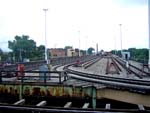 |
61stYard09.jpg (156k)
Looking north at 61st Yard from the East 63rd branch line tracks over 63rd Street on July 18, 2006. 61st Shops and various pieces of work equipment are visible in the north half of the yard in the distance. The curved track in the foreground provides a direct connection from the northbound East 63rd branch track (Track 2) leaving King Drive station and the yard's angled ladder track, providing more direct access to most of the yard's storage tracks as well as direct access to all but one shop track, compared to the access track along the west side of the yard. (Photo by Graham Garfield) |
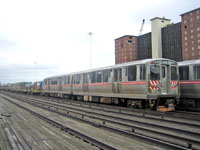
|
cta2403-work.jpg (199k)
In 1995, the first 22 2400-series cars were converted to work motors; later, another two were converted. To make them stand out from their unconverted brethren, they were given red-white-red side striping and red-white chevrons below the front end windows. All colored striping was reflective. Other changes on the cars included changing the control group wiring on the cars to a larger diameter wire, relocating the resistors out of the control group allowing their size to be increased, and adding a plug for passing the 600 volts DC to the flat cars on the side of the coupler. Work motor 2403 and its mate make up one end of a work train, followed by two flat cars and another 2400 work motor unit at the other end, in 61st Yard on January 13, 2007. (Photo by Graham Garfield) |
|
61stYard10.jpg (146k)
The 61st Yard is seen looking northwest from its southeast corner on January 13, 2007. On this particular day, the south half of the yard has a number of pieces of work equipment on it, including a a tank car (often used for weed spraying) on Track 5S and two trains of 2400-series work-capable motor cars. (Photo by Graham Garfield) |
|
61stYard12.jpg (204k)
This view looking south on the East 63rd (Jackson Park) branch on September 18, 2009, shows the 61st Yard on the left, the angled yard leads that cut diagonally across the yard and the connection to the mainline in the right foreground, the connection to the Lower 63rd Yard in the background behind the inbound Green Line train, and in the right middle the 61st Tower that controls the interlocking protecting it all. Note the double slip switch where the south lead and the inbound mainline track cross. (Photo by Graham Garfield) |
|
ctaS-502.jpg (141k)
One of CTA's four diesel locomotive snowfighter units, S-502, sits in the yard outside of 61st Shops on shop track D on September 18, 2009. The diesel snowfighters, built in 1986 by Niigata, are useful for clearing large snow drifts on ballasted "L" tracks. Each snowfighter actually consist of three units: the main unit is the diesel locomotive, the A unit is a broom attachment, and the B unit is an auger attachment. Here, the B unit is connected to the locomotive, but the A unit is disconnected and inside the shop. Their self-propelled design, not relying on 600V traction power like most "L" equipment, is especially useful when the snow covers the third rail. The locomotive unit is sometimes also used for other purposes, such as moving work equipment, at times when traction power is otherwise unavailable. (Photo by Graham Garfield) |
|
61stYard13.jpg (153k)
Looking north at the far north end of 61st Yard from a passing IRM fantrip train on March 28, 2010 shows the abrupt end to the tracks and yard where the shop building had once been. There is a guardrail along the edge of elevated yard where the threshold of the shop once was, with warning signs for protection. The low building on the left was a switchman's shanty and yardmaster's office when the 61st Yard stored passenger equipment. The booth on stilts was for a security officer to watch the yard at night. Note the track marker flag labeling the track in the middle as Track A. This is a remnant from when the shop existed, as "Track A" was the track's designation inside the inspection shop. The track's designation in the yard is Track 1N. (Photo by Graham Garfield) |
|
61stYard14.jpg (116k)
This view looking south from an IRM fantrip train on March 28, 2010, shows the north end of 61st Yard, now coming to an abrupt end with the removal of the 61st Shops. The large, empty lot, graded with gravel, is where the shop building once stood. (Photo by Graham Garfield) |
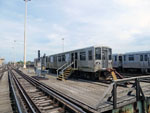 |
cta2273a.jpg (201k)
Cars 2273-74 sit in the southwest corner of 61st Yard on May 20, 2013, converted into crew facilities for the switchmen assigned to 61st Yard. Note the air conditioner units connected to the cars (rather than using the AC built into the cars), and the wooden staircase built for access so crew wouldn't use to climb in using the stirrups. The use of retired railcars for yard crew facilities has a long 'L' tradition, but was virtually unheard of in recent decades.
(Photo by Graham Garfield) |
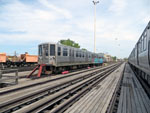 |
cta2273b.jpg (203k)
The 61st Yard crew room cars,
2273-2274, are seen at the south bumping post of track #1S is 61st Yard on May 20, 2013. Note the red third rail covers preventing the cars' third rail shoes from making contact with the third rail. The cars' lights were powered through a hard-wired connection to the yard's electrical service, and air conditioning was provided with independent units rather than the cars' air comfort system. Unfortunately, a graffiti tagger has hit car 2274. (Photo by Graham Garfield) |
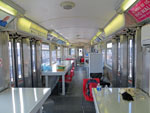 |
cta2273c.jpg (193k)
Car 2273 was designated as a crew break room, and as such was outfitted with tables, chairs, a telephone, a refrigerator, a microwave and power outlets so that crews could use the car as they would the switching shanty or trainroom at any other terminal during down time. The car interior is seen on May 20, 2013. Note that the car still has its advertisements and maps from when it was in passenger service. (Photo by Graham Garfield) |
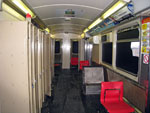 |
cta2274b.jpg (197k)
Car 2274 was set up as a locker room, so that crew members had a place to change clothes. Most of the seats were removed from the car, and lockers were installed. The #2 end of the car was partitioned off beyond the side doors, with the area divided in half with a locking door to access each, to provide private dressing rooms since the car was co-ed. The windows were blacked out with vinyl to provide privacy from the outside. This interior view of the car is on January 16, 2014, several months after the yard was no longer used for passenger cars. (Photo by John Blum) |
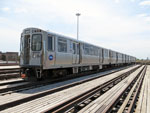 |
cta5103.jpg (210k)
Car 5103 is at the front of a row of 5000-series cars parked in 61st Yard between trips on the Green Line, seen looking southeast on January 16, 2014. (Photo by Graham Garfield) |
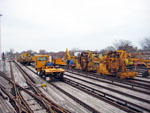 |
61stYard15.jpg (233k)
An array of the work and maintenance equipment is seen parked in the north half of 61st Yard on March 28, 2010. (Photo by Graham Garfield) |
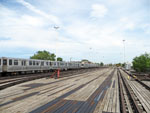 |
61stYard16.jpg (198k)
61st Yard is seen looking north from the south end of the yard on May 20, 2013. The large expanse of wooden footwalk decking is the result of several tracks having been removed from the yard over the years; some of the boards are very fresh, suggesting at least some tracks may have been removed fairly recently. Several 5000-series cars are seen on the other south storage tracks in the yard, parked for the midday lull when fewer cars are needed to fill the scheduled service. (Photo by Graham Garfield) |
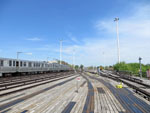 |
61stYard17.jpg (201k)
The large 61st Yard, once with an enormous storage capacity of 176 cars in the mid-1970s, has had its capacity reduced in stages over the years as tracks were removed for varied reasons including fire damage, yard renovations, and most recently reduced need. By the early 2000s, the capacity was down to 84 cars; by 2014, it was even less. Looking north in the yard on May 20, 2013, the flag for Track #8S still stands on the footwalk though the track it once marked has been removed. (Photo by Graham Garfield) |
 |
63rdYard01a.jpg (180k)
The Lower 63rd Yard, used for material storage, is seen from a passing train looking south on April 6, 1986. While some was stored inside, many of the materials were stored outside between the yard tracks (where there had also formerly been additional tracks years earlier). In evidence are ties, tie plates, rails, and other items. (Photo by John Smatlak) |

|
63rdYard02.jpg (152k)
The Lower 63rd Yard is seen looking south from the incline up to the East 63rd branch mainline tracks on March 28, 2010, during an IRM fantrip. The ground-level yard has widely-spaced non-powered (without third rail) tracks, between which materials (like the railroad ties and other items seen here) are stacked for storage and loading onto work cars for distribution around the "L" system. (Photo by Graham Garfield) |
 |
cnsm227.jpg (109k)
With the success of the North Shore Line's express package service, additional cars were needed. Bought between 1922-24 from the Cincinnati Car Co., in a change from the previous 203-class express cars, the 215-class cars had a single freight door located in the center of the car instead of two doors at each end. Merchandise despatch car 227 is seen in Lower 63rd Yard with the ramp up to the Jackson Park branch elevated on the left. (Photo from the
Lou Gerard Collection) |

|
cta293.jpg (108k)
Former South Side car 293 has met a fate similar to many other wooden "L" cars: after being retired in June 1957, it sits on the Lower 63rd Yard on October 4, 1972. It has received a low-cost conversion, mostly consisting of blocking out the windows with plywood, into a stationary tool or storage car. (Photo by Steve Zabel, Collection of Joe Testagrose) |
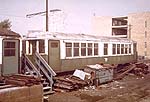
|
cta4083.jpg (131k)
Long after being decommissioned, car 4083 sits converted to a storage room in the Lower 63rd Street Yard on October 4, 1972. The removed center door -- only on the 1st version "baldie" 4000s -- is still evident in the metalwork. (Photo by Steve Zabel, Collection of Joe Testagrose) |

|
cta4427.jpg (141k)
Car 4427, seen here in the Lower 63rd Yard on July 4, 1971, appears to be consigned to work motor service here, though it was never officially converted to a service car. It was near the end of its life, as it would be scrapped exactly one year later in July 1972. (Photo by Joe Testagrose) |

|
cta4427b.jpg (117k)
Car 4427 is parked in the Lower 63rd Yard among the many construction materials that are commonly stored there on July 4, 1971. The Chicago Skyway is in the background on the right while a CHA apartment building can be seen on the left. (Photo by Joe Testagrose) |
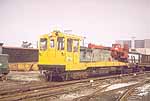
|
ctaS-332.jpg (118k)
Derrick S-332, seen in Lower 63rd Yard on October 4, 1972, has an unusual history: Wood car 1753 was converted to work motor S-332 in 1958. That car was stripped down to its frame and rebuilt as an unpowered derrick by 1965, christened S-332 II. It was equipped with 6000-series couplers in 1975. (Photo by Steve Zabel, Collection of Joe Testagrose) |
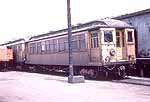
|
ctaS-338.jpg (98k)
Yet another work motor recycled from a 1950 CTA wood motor converted from a Northwestern Elevated trailer (in this case, car 1813 created from 1274), S-338 is in 63rd Street Yard on July 3, 1966. The car was scrapped two years later, in June 1968. (Collection of Joe Testagrose) |
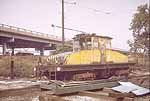
|
ctaS-343c.jpg (130k)
Work locomotive S-343 is in Lower 63rd Yard on October 4, 1972, with the Chicago Skyway in the background. (Photo by Steve Zabel, Collection of Joe Testagrose) |
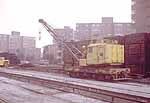
|
ctaS-223.jpg (108k)
Self-propelled diesel crane S-223 was purchased new by CTA in 1950. Built by Industrial Brownhoist, it was equipped with railroad couplers giving it the capability to spot freight carloads of supplies for unloading. It was still in active service at the Lower 63rd Street materials yard on October 4, 1972. (Photo by Steve Zabel, Collection of Joe Testagrose) |
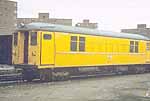
|
ctaS-347.jpg (103k)
S-347 was one of many work motors converted from 4000-series cars (many of which are shows below), in this case car 4323. It is in the 63rd Street Yard on August 6, 1972. (Photo by Bruno Berzins, Collection of Joe Testagrose) |
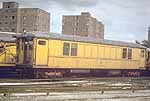
|
ctaS-348.jpg (115k)
4000-series car 4324, converted to work motor S-348 in February 1965, is in Lower 63rd Yard on August 6, 1972. (Photo by Bruno Berzins, Collection of Joe Testagrose) |
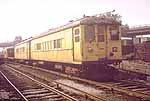
|
ctaS-350.jpg (127k)
Work motor S-350, known as car 4318 in its previous incarnation, is in the 63rd Materials Yard on October 4, 1972. (Photo by Steve Zabel, Collection of Joe Testagrose) |
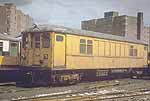
|
ctaS-350b.jpg (121k)
S-350, seen at 63rd Street on August 6, 1972, was the first of several S-350 series work motors that were equipped with snow plows. A wooden blade wouldn't stand up in service and a plain steel one could not safely clear ice off the third rail, so two-ply rubber flooring material was fastened to the blade with canvas backing to make it strong enough to move snow but flexible (and nonconductive) enough to be effective in service. (Photo by Bruno Berzins, Collection of Joe Testagrose) |
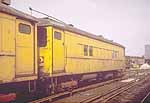
|
ctaS-356.jpg (107k)
In December 1965, car 4316 became one of twelve 4000-series units to be converted to work service, all with snow plows. Re-christened S-356, the car is in Lower 63rd Yard on October 4, 1972. (Photo by Steve Zabel, Collection of Joe Testagrose) |
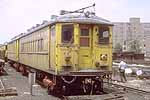
|
ctaS-358b.jpg (127k)
Work motor S-358, formally passenger car 4430, is waiting in Lower 63rd Yard between assignments on October 4, 1972. (Photo by Steve Zabel, Collection of Joe Testagrose) |
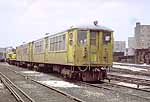
|
ctaS-359.jpg (120k)
Baldie car 4138 was one of only five of the center-door 4067-class 4000-series cars to be assigned to work service. Due to subway and canopy clearances, bald-roof cars were needed to service the Kennedy Line. 4138 became S-359, seen in Lower 63rd Yard with another baldie work motor (probably S-360) on July 4, 1971. (Photo by Joe Testagrose) |

|
ctaS-368.jpg (109k)
S-368 was one of another batch of 4000s converted for work service in 1972; seven cars were converted that year in all. S-368 is in the 63rd Materials Yard on October 4, 1972. (Photo by Steve Zabel, Collection of Joe Testagrose) |
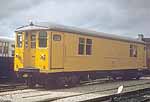
|
ctaS-368b.jpg (106k)
Ex-4386, renumbered S-368 in work service, had been a work motor for only four months when it was seen in the 63rd Street Yard on August 6, 1972. (Photo by Bruno Berzins, Collection of Joe Testagrose) |
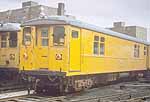
|
ctaS-370.jpg (110k)
Work motor S-370, formally car 4393, is among its 4000-series work car brethren in 63rd Yard on August 6, 1972. (Photo by Bruno Berzins, Collection of Joe Testagrose) |
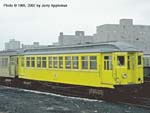
|
ctaS-339.jpg (61k)
Work motor S-339, built by American Car & Foundry in 1907 as Northwestern Elevated trailer 1276 (later motorized and renumbered to 1814 in 1950), was converted for work service in 1958. It's seen here at the Lower 63rd Street yard in March, 1965. (Photo by Jerry Appleman) |
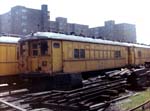
|
ctaS-358c.jpg (135k)
Work motor S-358, formerly Plushie 4000 car 4430, is in Lower 63rd Yard between runs in June 1968. The car was converted to a work motor two and a half years before in December 1965 and in winter was often equipped with a plow to act as a snowfighter. (Photo by Leon Kay) |
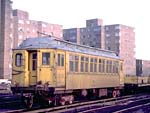
|
ctaS-332b.jpg (84k)
Chicago Transit Authority S-332, originally built by Jewett in 1906, was converted from ex-Northwestern car 1753 to work service in 1957. S-332 is parked in Lower 63rd Yard in April 1965. (Photo by Jerry Appleman) |
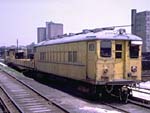
|
ctaS-348b.jpg (88k)
CTA work motor S-348 -- formerly 4000-series passenger car 4324, converted for work service in 1965 -- is seen with a work train at 63rd Street lower yard in June, 1968. (Photo by Jerry Appleman) |
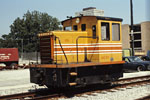 |
ctaMS-65.jpg (214k)
The MS-65 yard switching locomotive is seen in Lower 63rd Yard in July 1985. It is not clear why the fleet number for the unit is "MS" instead of the more typical "S" used for work (service) cars. One theory is that the "M" differentiated it as having a motor (internal combustion) rather than being electric, though if that was the case, then the pattern was not followed when the S-500 and S-501 classes of diesel locomotives/snow fighters were delivered/numbered. A second explanation is that the M-series of surface equipment was related to material handling, which would make sense given the unit's assignment to Lower 63rd where a warehouse is located. There was a railborne crane at South Shops that was the MS-70, the last active piece of rail rolling stock at that location. (Photo by Bruce Nelson) |
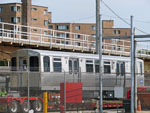 |
cta5675.jpg (295k)
Car 5675 sits on a low-boy trailer in Lower 63rd Yard on July 22, 2015. While Skokie Shops was isolated from the rest of the "L" system during mid-2015 due to an embankment collapse on the Yellow Line, 5000-series cars that had been delivered were stranded and had to be trucked to another yard on the system in order to be put into service; car 5675 was the first car transferred. (Photo by David Harrison) |
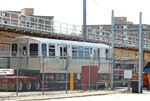 |
cta5677.jpg (243k)
5000-series car 5677 was in 63rd Lower Yard on July 24, 2015, still mounted on its trailer after being moved from Skokie, awaiting being moved off the trailer by the Shuttlewagon yard switching locomotive. (Photo by David Harrison) |
 |
cta5682.jpg (143k)
Car 5682 is at the end of its journey being trucked from Skokie Shops to 63rd Yard, as the trailer truck turns from East 63rd Street into the yard's front gate on July 31, 2015. Note the particularly low floor of the trailer -- this is necessary so the load can clear under viaducts, but also makes the routing very tightly planned. (Photo by David Harrison) |
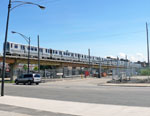 |
cta5044-43-5683-82-5681-80.jpg (187k)
A drag train is taking a group of recently-delivered 5000-series cars from Lower 63rd Yard, where they were trucked from Skokie Shops individually and then mated into married pairs, to the Red Line, where they will go into service. The eight-car drag train, seen on August 6, 2015 over 63rd Street on the incline from the lower yard to the Green Line elevated, is lead by unit 5044-43 (assigned to the Pink Line at the time), followed by newly-delivered units 5684-83 and 5682-81. The last unit is most likely another set that was already on property, assigned to the Green or Pink lines, acting as a buffer car. (Photo by David Harrison) |
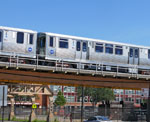 |
cta5683-5682.jpg (248k)
Newly-delivered 5000-series cars 5683 and 5682 are seen in the middle of a transfer train on August 6, 2015, over 63rd Street, being taken from Lower 63rd Yard to their assigned line via the Green Line. (Photo by David Harrison) |
 |
cta5688.jpg (242k)
5000-series car 5688 has made it to its destination at 63rd Lower Yard on August 11, 2015, after being trucked there from Skokie Shops on the opposite end of the "L" system. The new cars were delivered to Skokie Shops, just as the preceding 650+ had been, but could not get to their assigned lines from there due to the cutoff of the Yellow Line from the rest of the system due to a temporary embankment collapse caused by the nearby work of a contractor unaffiliated with CTA. Car 5688 will be paired with its mate, 5687, and placed into service from 63rd Yard. (Photo by David Harrison) |
|

|

|
Notes:
1. "Owners in control: Contractors for the Alley "L" deliver their work," Chicago Daily Tribune. January 23, 1893, pg. 3
2.
"Interurban Service Extended Through Chicago", Electric Railway Journal, Vol. 59 No. 21, May 27, 1922, p. 886
3. "Facilities Provided for Merchandise Dispatch Service", Electric Railway Journal, Vol. 60 No. 13, September 23, 1922, p. 466-67
4. Department of Planning and Development [DPD], "Non-Revenue Rail Vehicle Maintenance Facility." Presentation to Chicago Plan Commission, Jan. 21, 2021. CPC meeting presentation [PDF]. Accessed February 27, 2021.
5. Ibid.
6.
Ibid.
7.
Belanger, Christian. "Transit-oriented development in Bronzeville passes through Plan Commission." Hyde Park Herald, January 21, 2021.
8. Ibid.
9. DPD, ibid
.











